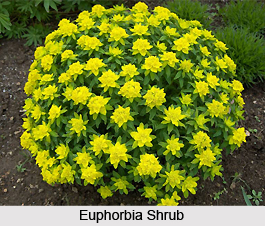 Euphorbia is a yearly herb, climbing up or upright upto 50 cm in height. It grows as a weed and is known by various names like, `Australian asthma weed`, `snake weed` and `cat`s hair`. It has circular stems, covered with yellowish hairs, tiny leaves, dark green on the upper side and pallid on the lower side and diminutive whitish flowers in small stalked bunches. It has small hairy fruits; and 3-angled, wrinkly, light reddish brown seeds. The whole plant, plucked in blooming and fruit bearing stages and dried, makes up the drug.
Euphorbia is a yearly herb, climbing up or upright upto 50 cm in height. It grows as a weed and is known by various names like, `Australian asthma weed`, `snake weed` and `cat`s hair`. It has circular stems, covered with yellowish hairs, tiny leaves, dark green on the upper side and pallid on the lower side and diminutive whitish flowers in small stalked bunches. It has small hairy fruits; and 3-angled, wrinkly, light reddish brown seeds. The whole plant, plucked in blooming and fruit bearing stages and dried, makes up the drug.
The herb had arrested the attention of allopathic physicians several years ago. They came to India and it was at their insistence that the drug was introduced in Europe approximately around 1884. The alcoholic infusion of the entire plant is used in contemporary allopathic medicine.
The chemistry of the drug illustrates it to comprise gallic acid, quercetin, a new phenolic substance, traces of a volatile oil, in addition to an alkaloid.
Methods of usage
Euphorbia has the capability to cure severe disorders like respiratory ailment, diarrhoea, genital trouble, intestinal worm, or trouble in lactating.
Healing Power and Medicinal Properties of euphorbia
The leaves are useful in checking bleeding and in counterbalancing convulsive disorders. They alleviate feverishness and give rise to a feeling of coolness. They have a comforting effect on the skin and the mucous membranes. They act as a mild purgative. The leaves have hard cellulose content. Raw juice, paste, powder and decoction can be prepared from 15 grams of these leaves and blended with 5 grams of holy basil or tulsi.
Respiratory Disorders cured by euphorbia
The drug basks in immense esteem in the Ayurvedic system of medicine and is assumed to be a most efficient remedial for diseases of the respiratory tract in general, particularly cough, coryza or colds in the head, bronchitis and asthma. It induces a sedative action on the heart and respiration, in addition to giving rise to a relaxation of the bronchioles.
Diarrhoea healed by euphorbia
Euphorbia is effective in curing diarrhoea. Approximately 12 grams of the herb mashed in water can be consumed to arrest the disease.
Genito-Urinary Disorders cured by euphorbia
Euphorbia is advantageous in the treatment of gonorrhoea and other venereal diseases. The plant is also of assistance in impotency, untimely ejaculations and spermatorrhoea or uncontrolled ejaculation.
Intestinal Worms healed by euphorbia
The leaves possess anthelmintic qualities and are constructive in treating intestinal worms amongst children.
Problem of Breast Milk Secretion remedied by euphorbia
The plant is exceedingly encouraging in boosting formation and flow of breast milk amongst lactating mothers.
Skin Disorders cured by euphorbia
The leaves of the plant are useful for treating skin disorders like ulcers. The paste of the plant can also be administered successfully on wounds and scalds. The milky juice of the plant is handy in the treatment of warts. It should be massaged externally on the affected portion.
Cracked Lips and Tongue healed by euphorbia
The milky juice of the plant can be applied on lips and tongue, in case of cracking or chapping.
Precautions - The drug should not be consumed in large dosages, because it may induce irritation in the stomach and result in vomiting.
Other Uses of euphorbia
Hair Tonic - If administered on the head, the milky juice of the plant is functional in boosting hair growth.











